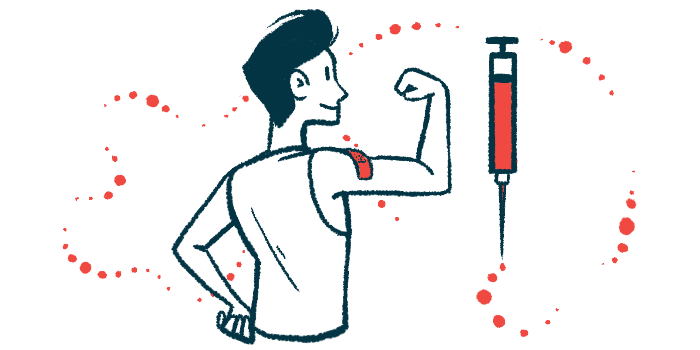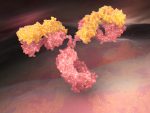Subcutaneous IG Found Effective for MG Adults in Small Study
All patients remained stable or improved clinically after treatment
Written by |

Subcutaneous immunoglobulin therapy (SCIg) — given by under-the-skin injection — was well-tolerated and effective in the management of adults with myasthenia gravis (MG), a small study has found.
Although the therapy is approved for other diseases related to immune system deficiency, and is currently under investigation as an MG treatment, it is not yet officially recommended for MG due to lack of data.
This study supports the use of SCIg as an alternative to the standard intravenously immunoglobulin therapy (IVIG), which is given by infusion directly into the bloodstream. Researchers noted that further studies are needed to confirm these findings.
The study, “Usefulness of subcutaneous immunoglobulin therapy in the management of myasthenia gravis: a retrospective cohort study,” was published in the Journal of Neurology.
In MG, self-reactive antibodies target and damage the neuromuscular junction, which is the region where nerves communicate with the muscles they control. As a result, people with the condition experience symptoms of weakness and fatigue that may affect muscles in the eyes, face, throat, limbs, and those involved in breathing.
Immunoglobulin (IG) therapy, consisting of immune globulins (immune proteins), is a treatment for MG patients with severe or rapidly worsening symptoms and is mainly administered intravenously. Although the mechanism of IVIG is unclear, it is thought to suppress the immune system and reduce the levels of harmful self-reactive antibodies.
Study compared 16 adults with generalized MG before and after SCIg
Due to the lack of data about SCIg for MG, researchers at the University of Bordeaux, in France, examined the medical records of 16 adult patients with generalized MG (11 female and five male patients), ages 19–83, and compared the severity of their symptoms before and after SCIg.
By the end of the study period, 11 had stopped SCIg, while nine were still being treated. The surgical removal of the thymus gland — a procedure called thymectomy — was performed on five patients.
All participants had been treated with IVIG six months before SCIg, and 13 received at least one immunosuppressive therapy when SCIg was started.
Reasons for starting SCIg included difficulties accessing veins and IVIG dependence — a condition in which there is a notable deterioration in symptoms during IVIG withdrawal. Because of low levels of immunoglobulins in the bloodstream or a lack of response, the average weekly SCIg dose was increased from 0.4 to 0.46 g/kg in 37.5% of patients.
SCIg response was measured by comparing the Myasthenia Gravis Foundation of America (MGFA) clinical classification before and after SCIg.
After SCIg, eight individuals (50%) improved across all levels of MGFA classifications, including three dropping from stage 4 to 3, reflecting a change from severe to moderate general muscle weakness. One patient improved from stage 4 to 1, or minimal symptoms; two from stage 3 to stage 2, with mild symptoms; one from stage 4 to stage 2; and one from stage 3 to 1.
The remaining eight individuals (50%) remained stable, with four in stage 4 and four in stage 3. None of the patients worsened clinically.
Hospitalizations, ICU visits, and intubations were reduced after SCIg
The number of days spent in the hospital per month was significantly reduced following SCIg relative to the period preceding treatment initiation. Time in the intensive care unit and the number of days intubated to assist breathing were also significantly reduced after treatment.
There was no change in the average number of daily treatments with anticholinesterase therapy, which is designed to improve nerve-muscle communication at the neuromuscular junction.
The median number of immunosuppressant treatments dropped from 2 to 1.5 at the end of SCIg, though this difference was not statistically significant. Yet, the dosage of anti-inflammatory corticosteroids was significantly reduced after SCIg treatment.
Further, the proportion of participants treated with the immunosuppressant azathioprine decreased, whereas the median number of rituximab treatment courses significantly increased.
After starting SCIg, fewer patients experienced myasthenic crises — a medical emergency when MG affects the muscles that control breathing. Less use of IVIG and plasma exchange for removing harmful antibodies from the bloodstream was also reported.
The median duration of SCIg treatment before needing IVIG, which occurred in seven patients (43.8%), was 21.4 months (a little less than two years).
Eight out of the 10 patients who attended a follow-up visit were still being treated with SCIg and were in favor of continuing treatment. One individual requested SCIg be given at home and IVIG in the hospital, one wanted to resume SCIg due to IVIG-related adverse effects, and one showed an interest in using skin patches to reduce injection pain and improve comfort.
The main reasons for stopping SCIg included a lack of response and interrupted SCIg supply.
Adverse effects such as deep skin lesions (subcutaneous nodules) were observed in eight participants after SCIg, rash at the injection site in four patients, headache in four, and itchy skin in two. Diarrhea, bruising at the injection site, medicine leakage, physical weakness, and a lung blood clot were each reported by one patient.
“We describe the successful management of MG patients using SCIg, which was validated by MGFA classification … , ICU hospitalizations, and the use of [intubation] in 16 patients,” the researchers wrote. “Further large-scale prospective studies [over time] are needed to confirm these results.”








Leave a comment
Fill in the required fields to post. Your email address will not be published.